
The mouth of this particular rabbit hole gaped wider with each page turned in Holt’s Rise of the Rocket Girls. The book’s tight focus follows several women as their computer skills helped make space flight possible, but the shutter opens to reveal a good deal about the JPL and the formation of NASA as well. For readers interested in the space race, women in STEM fields, or for those who’ve fervently wondered if life exists on other planets, this book and the others listed alongside it are must reads.
Start Here:
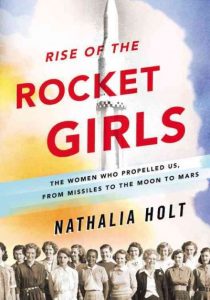 Nathalia Holt. Rise of the Rocket Girls: The Women Who Propelled Us, From Missiles to the Moon to Mars. 2016.
Nathalia Holt. Rise of the Rocket Girls: The Women Who Propelled Us, From Missiles to the Moon to Mars. 2016.
“In the 1940s and 50s, when the newly minted Jet Propulsion Laboratory needed quick-thinking mathematicians to calculate velocities and plot trajectories, they didn’t turn to male graduates. Rather, they recruited an elite group of young women who, with only pencil, paper, and mathematical prowess, transformed rocket design, helped bring about the first American satellites, and made the exploration of the solar system possible.
For the first time, Rise of the Rocket Girls tells the stories of these women—known as “human computers”—who broke the boundaries of both gender and science. Based on extensive research and interviews with all the living members of the team, Rise of the Rocket Girls offers a unique perspective on the role of women in science: both where we’ve been, and the far reaches of space to which we’re heading.”
Next Stop:
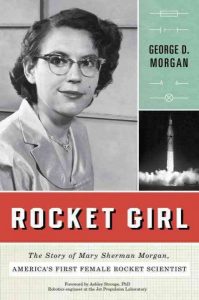 George D. Morgan. Rocket Girl: The Story of Mary Sherman Morgan, America’s First Female Rocket Scientist. 2013.
George D. Morgan. Rocket Girl: The Story of Mary Sherman Morgan, America’s First Female Rocket Scientist. 2013.
“Blending a fascinating personal history with dramatic historical events, this book brings long-overdue attention to a brilliant woman whose work proved essential for America’s early space program. This is the extraordinary true story of America’s first female rocket scientist. Told by her son, it describes Mary Sherman Morgan’s crucial contribution to launching America’s first satellite and the author’s labyrinthine journey to uncover his mother’s lost legacy–one buried deep under a lifetime of secrets political, technological, and personal. In 1938, a young German rocket enthusiast named Wernher von Braun had dreams of building a rocket that could fly him to the moon.
In Ray, North Dakota, a young farm girl named Mary Sherman was attending high school. In an age when girls rarely dreamed of a career in science, Mary wanted to be a chemist. A decade later the dreams of these two disparate individuals would coalesce in ways neither could have imagined. World War II and the Cold War space race with the Russians changed the fates of both von Braun and Mary Sherman Morgan. When von Braun and other top engineers could not find a solution to the repeated failures that plagued the nascent US rocket program, North American Aviation, where Sherman Morgan then worked, was given the challenge. Recognizing her talent for chemistry, company management turned the assignment over to young Mary. In the end, America succeeded in launching rockets into space, but only because of the joint efforts of the brilliant farm girl from North Dakota and the famous German scientist. While von Braun went on to become a high-profile figure in NASA’s manned space flight, Mary Sherman Morgan and her contributions fell into obscurity–until now.”
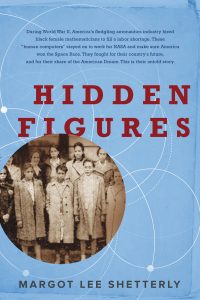 Margot Lee Shetterly. Hidden Figures: The American Dream and the Untold Story of the Black Women Mathematicians Who Helped Win the Space Race. Sept 2016.
Margot Lee Shetterly. Hidden Figures: The American Dream and the Untold Story of the Black Women Mathematicians Who Helped Win the Space Race. Sept 2016.
“Before John Glenn orbited the earth, or Neil Armstrong walked on the moon, a group of dedicated female mathematicians known as “human computers” used pencils, slide rules and adding machines to calculate the numbers that would launch rockets, and astronauts, into space.
Among these problem-solvers were a group of exceptionally talented African American women, some of the brightest minds of their generation. Originally relegated to teaching math in the South’s segregated public schools, they were called into service during the labor shortages of World War II, when America’s aeronautics industry was in dire need of anyone who had the right stuff. Suddenly, these overlooked math whizzes had a shot at jobs worthy of their skills, and they answered Uncle Sam’s call, moving to Hampton, Virginia and the fascinating, high-energy world of the Langley Memorial Aeronautical Laboratory.
Even as Virginia’s Jim Crow laws required them to be segregated from their white counterparts, the women of Langley’s all-black “West Computing” group helped America achieve one of the things it desired most: a decisive victory over the Soviet Union in the Cold War, and complete domination of the heavens.
Starting in World War II and moving through to the Cold War, the Civil Rights Movement and the Space Race, Hidden Figures follows the interwoven accounts of Dorothy Vaughan, Mary Jackson, Katherine Johnson and Christine Darden, four African American women who participated in some of NASA’s greatest successes. It chronicles their careers over nearly three decades they faced challenges, forged alliances and used their intellect to change their own lives, and their country’s future.”
A Little to the Left:
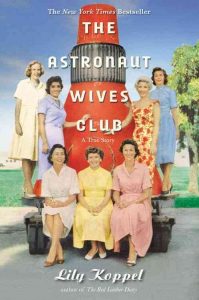 Lily Koppel. The Astronaut Wives Club: A True Story. 2014.
Lily Koppel. The Astronaut Wives Club: A True Story. 2014.
“As America’s Mercury Seven astronauts were launched on death-defying missions, television cameras focused on the brave smiles of their young wives. Overnight, these women were transformed from military spouses into American royalty. They had tea with Jackie Kennedy, appeared on the cover of Life magazine, and quickly grew into fashion icons.
Annie Glenn, with her picture-perfect marriage, was the envy of the other wives; JFK made it clear that platinum-blonde Rene Carpenter was his favorite; and licensed pilot Trudy Cooper arrived with a secret that needed to stay hidden from NASA. Together with the other wives they formed the Astronaut Wives Club, providing one another with support and friendship, coffee and cocktails.
As their celebrity rose-and as divorce and tragedy began to touch their lives-the wives continued to rally together, forming bonds that would withstand the test of time, and they have stayed friends for over half a century. THE ASTRONAUT WIVES CLUB tells the story of the women who stood beside some of the biggest heroes in American history.”
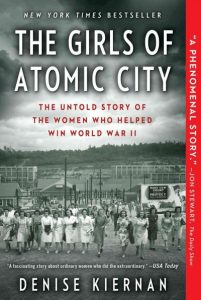 Denise Kiernan. The Girls of Atomic City: The Untold Story of the Women Who Helped Win World War II. 2014.
Denise Kiernan. The Girls of Atomic City: The Untold Story of the Women Who Helped Win World War II. 2014.
“At the height of World War II, Oak Ridge, Tennessee, was home to 75,000 residents, and consumed more electricity than New York City, yet it was shrouded in such secrecy that it did not appear on any map. Thousands of civilians, many of them young women from small towns across the U.S., were recruited to this secret city, enticed by the promise of solid wages and war-ending work. What were they actually doing there? Very few knew. The purpose of this mysterious government project was kept a secret from the outside world and from the majority of the residents themselves. Some wondered why, despite the constant work and round-the-clock activity in this makeshift town, did no tangible product of any kind ever seem to leave its guarded gates? The women who kept this town running would find out at the end of the war, when Oak Ridge’s secret was revealed and changed the world forever.
Drawing from the voices and experiences of the women who lived and worked in Oak Ridge, The Girls of Atomic City rescues a remarkable, forgotten chapter of World War II from obscurity. Denise Kiernan captures the spirit of the times through these women: their pluck, their desire to contribute, and their enduring courage. “A phenomenal story,” and Publishers Weekly called it an “intimate and revealing glimpse into one of the most important scientific developments in history.””
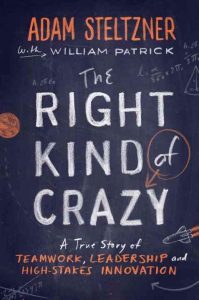 Adam Steltzner. The Right Kind of Crazy: A True Story of Teamwork, Leadership, and High-Stakes Innovation. 2016.
Adam Steltzner. The Right Kind of Crazy: A True Story of Teamwork, Leadership, and High-Stakes Innovation. 2016.
“The Jet Propulsion Laboratory (JPL) is home to some of history’s most jaw-dropping feats of engineering. When NASA needed to land Curiosity—a 2,000-pound, $2.5 billion rover—on the surface of Mars, 140 million miles away, they turned to JPL. Steltzner’s team couldn’t test their kooky solution, the Sky Crane. They were on an unmissable deadline, and the world would be watching when they succeeded—or failed.
At the helm of this effort was an unlikely rocket scientist and accidental leader, Adam Steltzner. After barely graduating from high school, he followed his curiosity to the local community college to find out why the stars moved. Soon he discovered an astonishing gift for math and physics. After getting his Ph.D. he ensconced himself within JPL, NASA’s decidedly unbureaucratic cousin, where success in a mission is the only metric that matters.”
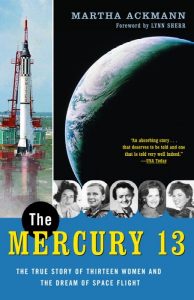 Martha Ackmann. Mercury 13: The True Story of Thirteen Women and the Dream of Space Flight. 2004.
Martha Ackmann. Mercury 13: The True Story of Thirteen Women and the Dream of Space Flight. 2004.
“In 1961, just as NASA launched its first man into space, a group of women underwent secret testing in the hopes of becoming America’s first female astronauts. They passed the same battery of tests at the legendary Lovelace Foundation as did the Mercury 7 astronauts, but they were summarily dismissed by the boys’ club at NASA and on Capitol Hill. The USSR sent its first woman into space in 1963; the United States did not follow suit for another twenty years.
For the first time, Martha Ackmann tells the story of the dramatic events surrounding these thirteen remarkable women, all crackerjack pilots and patriots who sometimes sacrificed jobs and marriages for a chance to participate in America’s space race against the Soviet Union. In addition to talking extensively to these women, Ackmann interviewed Chuck Yeager, John Glenn, Scott Carpenter, and others at NASA and in the White House with firsthand knowledge of the program, and includes here never-before-seen photographs of the Mercury 13 passing their Lovelace tests.
Despite the crushing disappointment of watching their dreams being derailed, the Mercury 13 went on to extraordinary achievement in their lives: Jerrie Cobb, who began flying when she was so small she had to sit on pillows to see out of the cockpit, dedicated her life to flying solo missions to the Amazon rain forest; Wally Funk, who talked her way into the Lovelace trials, went on to become one of the first female FAA investigators; Janey Hart, mother of eight and, at age forty, the oldest astronaut candidate, had the political savvy to steer the women through congressional hearings and later helped found the National Organization for Women.”
Find it in Fiction:
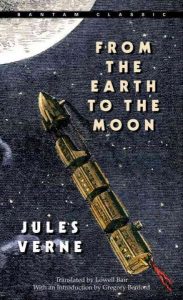 Jules Verne. From the Earth to the Moon.
Jules Verne. From the Earth to the Moon.
Written almost a century before the daring flights of the astronauts, Jules Verne’s prophetic novel of man’s race to the stars is a classic adventure tale enlivened by broad satire and scientific acumen.
When the members of the elite Baltimore Gun Club find themselves lacking any urgent assignments at the close of the Civil War, their president, Impey Barbicane, proposes that they build a gun big enough to launch a rocket to the moon. But when Barbicane’s adversary places a huge wager that the project will fail and a daring volunteer elevates the mission to a “manned” flight, one man’s dream turns into an international space race.
A story of rip-roaring action, humor, and wild imagination, From the Earth to the Moon is as uncanny in its accuracy and as filled with authentic detail and startling immediacy as Verne’s timeless masterpieces 20,000 Leagues Under the Sea and Around the World in Eighty Days.”
 Lydia Netzer. How to Tell Toledo from the Night Sky. 2015.
Lydia Netzer. How to Tell Toledo from the Night Sky. 2015.
“Like a jewel shimmering in a Midwest skyline, the Toledo Institute of Astronomy is the nation’s premier center of astronomical discovery and a beacon of scientific learning for astronomers far and wide. Here, dreamy cosmologist George Dermont mines the stars to prove the existence of God. Here, Irene Sparks, an unsentimental scientist, creates black holes in captivity.
George and Irene are on a collision course with love, destiny and fate. They have everything in common: both are ambitious, both passionate about science, both lonely and yearning for connection. The air seems to hum when they’re together. But George and Irene’s attraction was not written in the stars. In fact their mothers, friends since childhood, raised them separately to become each other’s soulmates.
When that long-secret plan triggers unintended consequences, the two astronomers must discover the truth about their destinies, and unravel the mystery of what Toledo holds for them―together or, perhaps, apart.”


